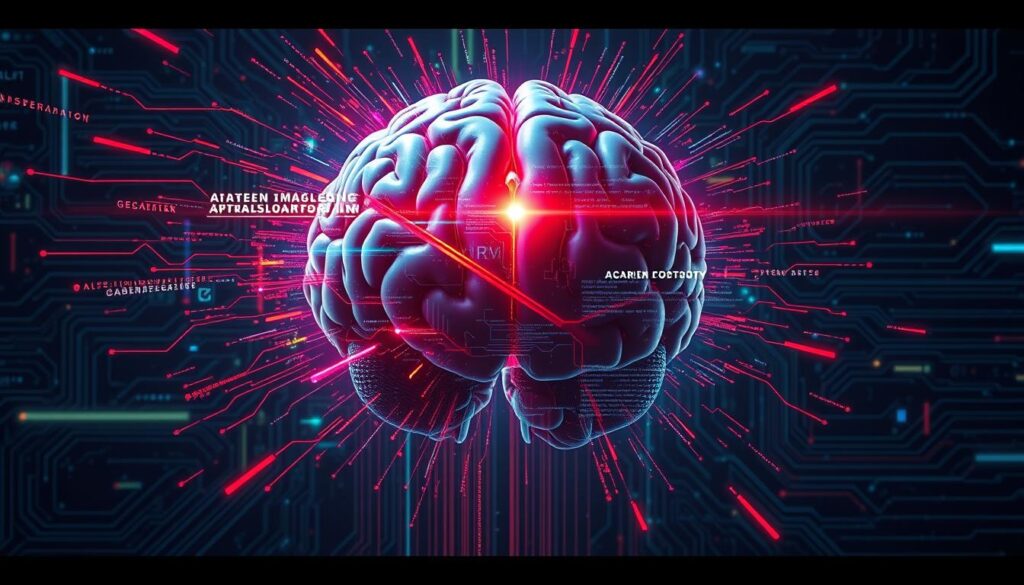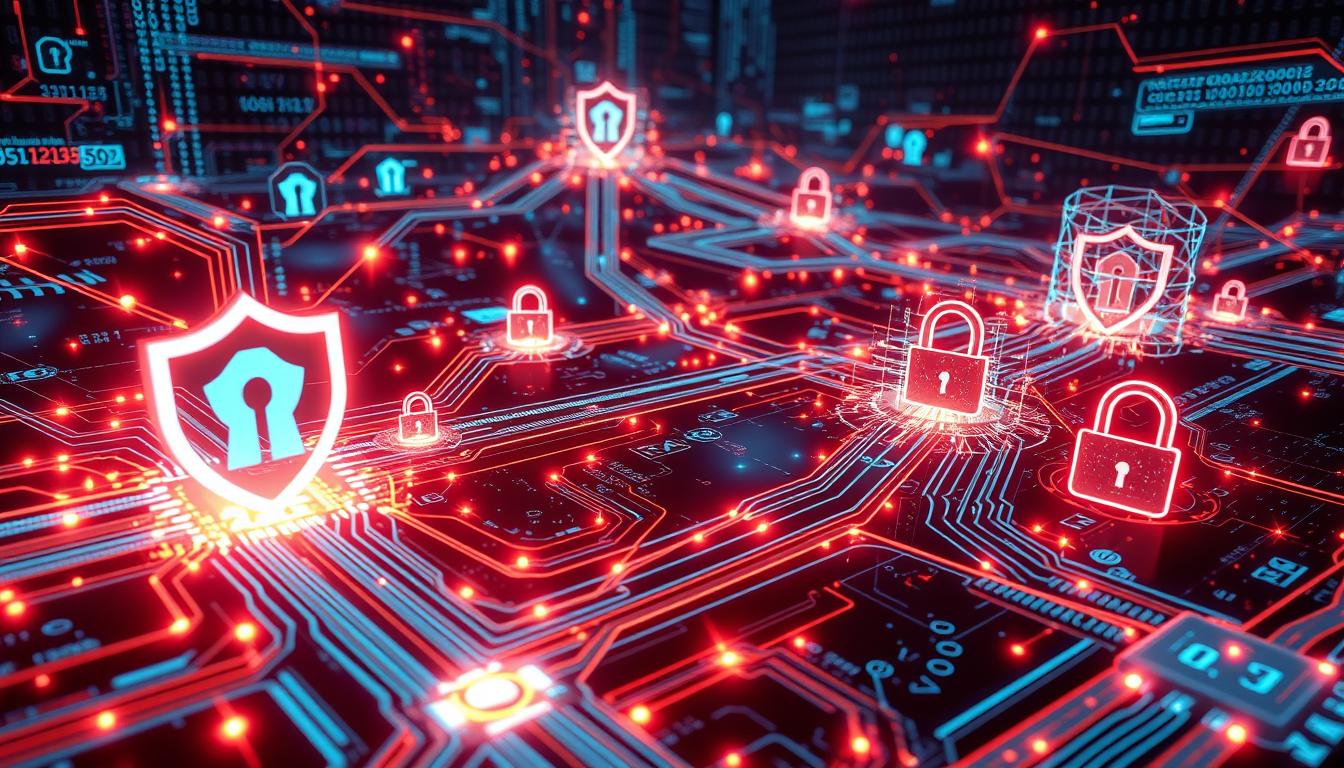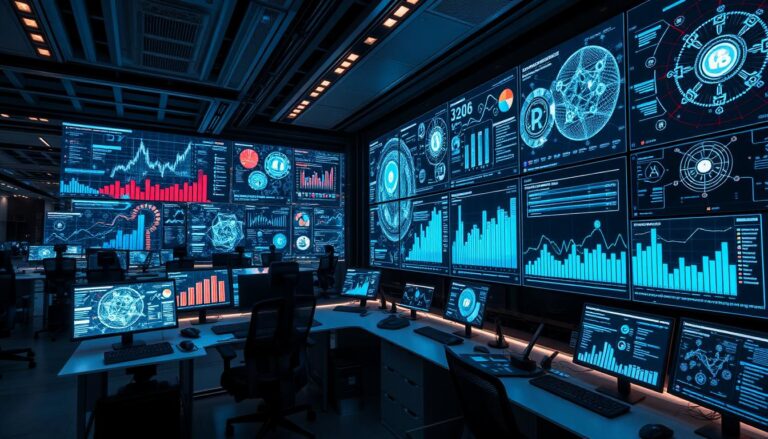It is imperative that nearly 60% of businesses face breaches because they don’t use AI in security? Traditional methods like rule-based detection can’t keep up with today’s threats1. AI has changed the game, helping companies fight threats faster and more accurately than ever before. It uses machine learning and predictive analytics to spot dangers in real-time2.
With cyber threats growing, AI is now a must-have for security3. It’s not just a tool; it’s a key part of keeping systems safe.
Key Takeaways
- AI makes threat detection faster and more effective than old methods.
- Machine learning helps spot complex threats better.
- AI automates responses, reducing the damage from cyber attacks.
- AI keeps security up to date in real-time.
- AI is crucial for keeping up with changing cyber threats.
Understanding AI Cybersecurity Basics
AI cybersecurity uses advanced tech to understand and act on big data. It’s a game-changer for spotting and stopping threats. This helps companies stay safe from cyber dangers.
What is AI in Cybersecurity?
AI in cybersecurity uses smart algorithms and machine learning to fight threats. It makes security systems work better by automating simple tasks. This lets them focus on the real dangers, making companies safer.
This tech is growing fast, with a market value of about $15 billion in 2021. It’s expected to hit around $135 billion by 20304.
Key Components of AI Security Systems
AI security systems go through three stages: assisted, augmented, and autonomous intelligence. Each stage gets better at finding and fixing threats fast. By using machine learning, natural language processing, and behavioral analytics, companies can watch user actions and understand data better. This boosts their ability to manage risks5.
Importance of Machine Learning in Security
Machine learning is key in cybersecurity. It lets systems check big data fast and predict threats. This makes threat detection faster and more accurate, cutting down on false alarms4.
Machine learning keeps getting better, adapting to new threats and weaknesses. This makes AI solutions more effective over time5.
The Evolution of Threat Detection
Cybersecurity has changed a lot over time. It’s a constant fight against new and tricky cyber threats. Knowing how it has changed helps businesses create strong security plans. The move to AI-powered systems is a big step forward in fighting threats.
Historical Context of Cyber Threats
At first, digital security used simple rules. Later, in the 1980s and 1990s, it added signature and heuristic methods. But, as threats got more complex, these old ways couldn’t keep up. Now, we need AI to handle big data fast and keep us safe.
Traditional vs. AI-Powered Detection
Old ways of finding threats were slow and costly. In 2020, it took 280 days to find and fix data breaches, costing $3.86 million on average6. AI changes this, letting systems check huge amounts of data quickly. This cuts down on time and cost, making security better.
Case Studies of AI in Action
AI has helped many companies. Azure Sentinel cuts down detection time to minutes. Azure Defender protects different places. These tools help teams work better and respond faster to threats6. They show how AI can make security teams more effective.
How AI Enhances Threat Detection
In today’s digital world, AI is key in improving threat detection. It helps spot anomalies, predict threats, and analyze user behavior. This gives companies a strong defense against cyber attacks.
Anomaly Detection: The AI Advantage
Anomaly detection AI is a big help. It quickly checks network traffic, system logs, and user activity. It finds small changes that others might miss, helping spot cyber threats.
AI can look at huge amounts of data fast. This makes it better at finding threats and acting quickly7. Using AI, companies can handle security alerts automatically. This makes work easier for security teams and helps them work better7.
Predictive Analytics in Threat Forecasting
Predictive analytics cybersecurity is all about being proactive. AI looks at past data and threat feeds to guess future attacks7. This lets companies plan ahead and avoid risks.
Companies using predictive analytics see faster alert handling. They improve their security by about 55%8.
Behavior Analysis using AI Tools
Behavioral analytics AI watches user actions all the time. It catches early signs of threats and compromised accounts. This lets companies act fast when threats appear.
Companies using AI and automation save a lot of money. They cut data breach costs by USD 3 million on average8.

Types of Threats AI Can Combat
In today’s world, AI is key in fighting threats like malware, ransomware, and phishing. It uses advanced algorithms and machine learning to improve threat detection. This leads to stronger defense strategies for organizations.
Malware and Ransomware Detection
AI is great at finding malware by quickly analyzing lots of data. It can keep up with new threats and attack methods. This means AI can stop harmful software before it harms a lot.
Studies show AI systems are 80% to 92% effective in security, beating traditional methods9. This helps companies fight ransomware better. They can spot ransomware attacks early, reducing their risk of cyber attacks.
Phishing Identification Techniques
AI uses smart methods to check emails for phishing. It can tell real emails from fake ones with 94% accuracy9. This means AI can catch phishing threats fast, keeping data safe.
Insider Threat Detection with AI
AI watches how users act to find insider threats. It looks for signs of insider attacks, both intentional and not. AI checks many data sources to give a full view of threats10.
Real-Time Response and Mitigation
In today’s world, quick response to threats is key. AI has made these processes faster and better. It’s important to know what makes this possible.
Automated Incident Response Systems
Automated systems are crucial for fast threat handling. They use AI to check network traffic for odd patterns. This helps spot threats quickly, which is vital since 90% of threats can be caught early11.
The Role of AI in Threat Containment
AI helps contain threats by learning from data. It spots unusual behavior, leading to quick responses. In a world where 70% of threats are hard to catch, AI is a game-changer12.
Continuous Monitoring and Learning
AI systems keep getting better as they learn from new threats. They help organizations stay one step ahead of risks. This proactive approach saves resources and reputation11.

AI Cybersecurity Tools You Should Know
The world of cybersecurity is changing fast. New AI security solutions are helping companies protect themselves better. These tools use advanced tech to spot and stop cyber threats before they happen.
Overview of Leading AI Security Solutions
Top AI tools like Darktrace, SentinelOne, and CrowdStrike are key for today’s security. They watch for unusual activity, find odd patterns, and fight threats with AI. This helps keep your systems safe.
Comparing AI Tools: Features and Benefits
When picking AI tools, look at their main features:
- Scalability: They should grow with your company.
- Ease of integration: They should work well with what you already have.
- Real-time threat detection: They should catch threats fast.
- Autonomous functionality: Tools like AI-based intrusion detection systems can spot and alert you to suspicious network activity.
Explainable AI (XAI) builds trust by showing how AI makes decisions13. Behavioral analysis tools are also key. They learn what’s normal and quickly spot anything out of place14.
Future Trends in AI Security Technology
Future trends in AI security include better natural language processing and data analysis. Zero Trust Architecture, powered by AI, will change how access is granted based on user behavior and risk13. As more companies use AI, they’ll aim to automate threat response and keep improving their security.

Challenges AI Faces in Cybersecurity
Using AI in cybersecurity comes with big challenges. One major issue is the quality and availability of data. AI needs lots of good data to work well. Poor data can make AI less effective at spotting threats.
Companies must use high-quality data to train AI. This helps avoid problems with AI’s performance.
Limitation of Data Quality and Accessibility
AI needs lots of data to improve its accuracy. Without good data, AI might not work as well. This can lead to more false alarms and missed threats.
Cybercriminals use these data issues to their advantage. They use advanced techniques to hide their activities. This makes it hard for AI to detect them15. It’s crucial to have strong data management in place.
Evasion Techniques Used by Cybercriminals
Cybercriminals keep finding new ways to evade AI security. They use AI to make phishing emails more convincing. This makes it tough for AI to catch these threats16.
This creates a constant battle between cybersecurity experts and hackers. Both sides keep finding new ways to outsmart each other15. Companies must stay alert and adapt to these new tactics.
Ethical Considerations of AI in Security
AI in security raises important ethical questions. There’s a risk of biases in AI, which can affect its performance16. AI might also make decisions without enough human oversight, which can be risky.
It’s vital for companies to use AI responsibly. They should make sure AI is fair and that humans are involved in important decisions17.

Implementing AI in Your Cybersecurity Strategy
To add AI to your cybersecurity plan, you need a clear strategy. First, figure out what your organization really needs. Look at your cybersecurity to find weak spots AI can help fix.
Steps for Adopting AI Solutions
Begin by checking your current security setup and see where it can get better. Make a detailed plan that includes:
- Integration: Make sure the AI tools fit well with what you already have.
- Training: Teach your team how to use the new AI tools.
- Testing: Try out AI in small ways to see how it works.
Assessing Your Organization’s Needs
Keep checking what your organization needs as you go. This is key to knowing where AI can help the most, like:
- Finding areas that are most at risk of cyber attacks.
- Knowing what rules you must follow in your field.
- Figuring out what data you need to protect, like customer info or company secrets.
Measuring the ROI of AI in Security
Figuring out if AI is worth it can be tough but it’s very important. Look at both the good things and the numbers, such as:
- Seeing fewer breaches because of AI’s help in finding threats.
- AI catching more threats than before.
- Having a stronger security setup, which makes everyone trust you more.
By watching these signs, you can see if your AI efforts are paying off181.

The Future of AI in Cybersecurity
Artificial intelligence is changing how we fight cyber threats. New tech like deep learning makes systems faster and more accurate. The AI cybersecurity market is expected to grow by 27.8% by 203019.
Emerging Technologies in AI Security
Companies are putting more money into AI for better security. We’ll see more automated systems that need less human help. New tools like Natural Language Processing will help fight smarter cyber attacks20.
AI is getting better at stopping threats before they happen. This means a stronger defense against cyber attacks21.
Predictions for AI Threat Detection
AI in cybersecurity will get even better. We’ll see more use of predictive analytics and learning from user behavior. This will make your organization more ready for AI threats19.
It’s important for companies to keep training and investing in AI. This will help them stay ahead of cybercriminals and keep their systems safe19. Learn more about AI’s impact on cybersecurity in this resource.
FAQ
What is AI in Cybersecurity?
How does AI enhance threat detection?
What are the key components of AI security systems?
Can AI effectively combat malware and ransomware attacks?
What are automated incident response systems?
What challenges does AI face in cybersecurity?
What is predictive analytics in cybersecurity?
How can organizations prepare for the future of AI in cybersecurity?
What ethical considerations arise from using AI in cybersecurity?
How do I measure the ROI of AI in security?
Source Links
- What Is the Role of AI in Threat Detection? – https://www.paloaltonetworks.com/cyberpedia/ai-in-threat-detection
- What Is the Role of AI in Cybersecurity? – https://www.excelsior.edu/article/ai-in-cybersecurity/
- The Role of AI in Cybersecurity – https://www.crowdstrike.com/en-us/cybersecurity-101/artificial-intelligence/?srsltid=AfmBOopGdSmBSz0eSlgEeaxsKZqwvz-e4ytrJ5GYJRM8U8SgduLJoCbn
- AI and Cybersecurity: A New Era | Morgan Stanley – https://www.morganstanley.com/articles/ai-cybersecurity-new-era
- Artificial Intelligence in Cybersecurity – https://www.balbix.com/insights/artificial-intelligence-in-cybersecurity/
- AI in Cybersecurity: Revolutionizing Threat Detection, Decision-Making, and Beyond – Intwo – https://www.intwo.cloud/news-blog/ai-in-cybersecurity-revolutionizing-threat-detection-decision-making-and-beyond/
- Role of Artificial Intelligence (AI) in Threat Detection – https://www.sangfor.com/blog/cybersecurity/role-of-artificial-intelligence-ai-in-threat-detection
- Artificial Intelligence (AI) Cybersecurity | IBM – https://www.ibm.com/ai-cybersecurity
- AI in Cyber Security: Top 6 Use Cases – TechMagic – https://www.techmagic.co/blog/ai-in-cybersecurity
- AI in Cybersecurity – Uses, Threats & Prevention | 2024 | Engati – https://www.engati.com/blog/ai-in-cybersecurity
- AI Threat Detection: Leverage AI to Detect Security Threats – https://www.sentinelone.com/cybersecurity-101/data-and-ai/ai-threat-detection/
- Real-Time Threat Detection: Keeping Your Business Safe – https://smarttechfl.com/blog/real-time-threat-detection/
- 7 AI Cybersecurity Tools You Should Know – Naperville, Aurora, St. Charles | WEBIT Services – https://www.webitservices.com/blog/ai-cybersecurity-tools/
- No title found – https://www.kriptos.io/en-post/ai-in-cybersecurity
- AI and Cyber Security: Innovations and Challenges – https://www.esecurityplanet.com/trends/ai-and-cybersecurity-innovations-and-challenges/
- The Benefits And Challenges Of AI In Cyber Security – https://www.metacompliance.com/blog/data-breaches/benefits-and-challenges-of-ai-in-cyber-security
- The AI Cyber Security Challenge – https://kpmg.com/nl/en/home/insights/2024/06/ai-cyber-security-challenge.html
- AI Cyber Security: Securing AI Systems Against Cyber Threats – https://www.exabeam.com/explainers/ai-cyber-security/ai-cyber-security-securing-ai-systems-against-cyber-threats/
- The Future of AI in Cybersecurity – https://www.visory.net/the-future-of-ai-in-cybersecurity/
- Future of AI in Cybersecurity: Key Technologies and Trends – https://www.sigmasolve.com/blog/the-future-of-ai-in-cybersecurity-emerging-technologies-and-trends/
- What are Predictions of Artificial Intelligence (AI) in Cybersecurity? – https://www.paloaltonetworks.com/cyberpedia/predictions-of-artificial-intelligence-ai-in-cybersecurity



